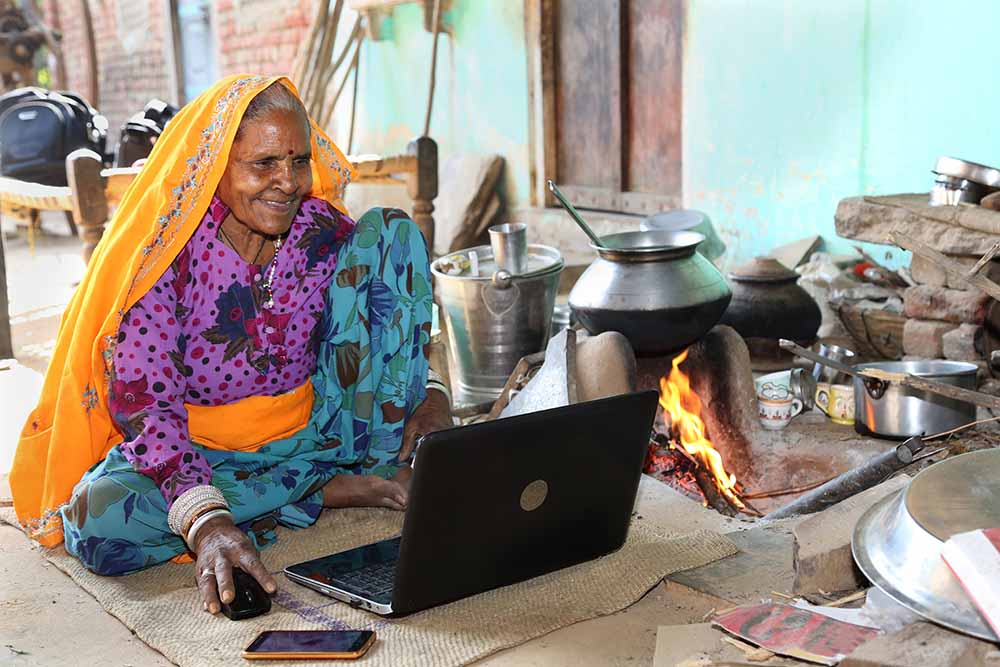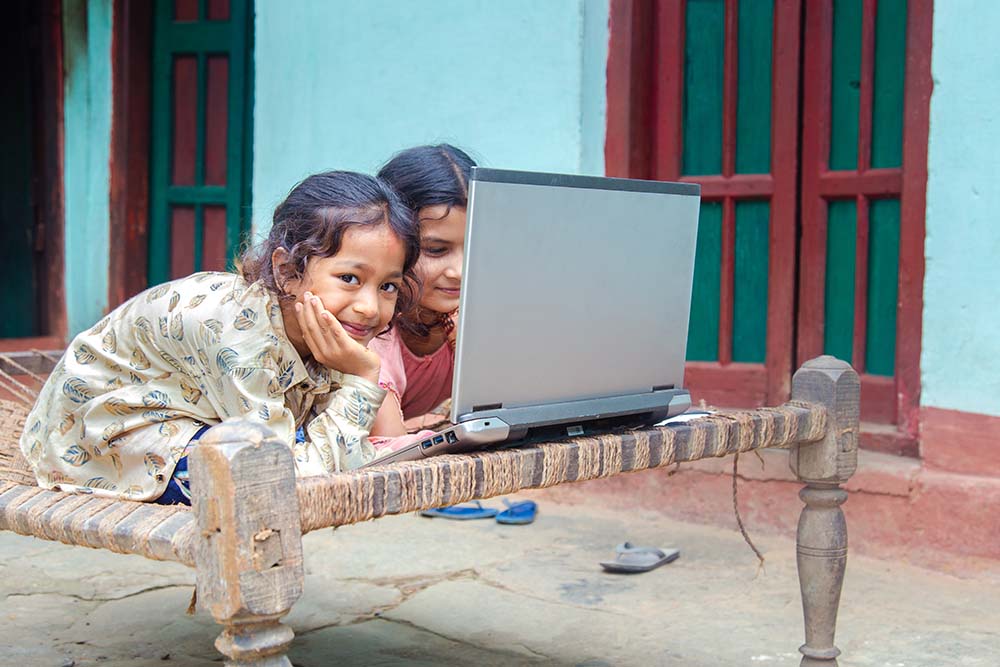Internet speeds are getting faster, digital devices are available at cheaper rates and in amazing new varieties, and yet there is a huge rural-urban digital divide living and growing right under our very noses. The National Family Health Survey-5 (NFHS-5) of India reveals that not only does this rural-urban digital divide exist, it also impacts women a lot more than it does men. The NFHS-5 shows that while in cities, 56 per cent of women have ever used the internet, it’s only 34 per cent of women in rural areas. Yes, that’s an inordinate amount of difference, highlighting the fact that the rural-urban divide is indeed quite real.
Similarly, a 2021 report titled India’s Gendered Digital Divide: How The Absence Of Digital Access Is Leaving Women Behind by the Observer Research Foundation (ORF), shows that the penetration of broadband in rural areas is still only at 29 per cent, while the national average is at 51 per cent. The report also shows that this rural-urban divide is widest in states like West Bengal, Gujarat, Maharashtra, Andhra Pradesh and Telangana.
Once again, these statistics prove that despite all the advancements, this rural-urban divide is crippling the Indian economy and society by limiting a large part of our population. Unless this gap is bridged, a part of the Indian population won’t have the opportunities or the equality they deserve. This is what makes the rural-urban digital divide a social justice issue, and one that you should definitely know more about.

The Rural-Urban Divide Was Always There
One of the unfortunate truths that everyone should know is that the rural-urban divide didn’t just spring up in the 2020s. It has always existed, and not just in India, but globally. A 2019 study conducted by researchers at the University of West Indies, titled Bridging the Urban-Rural Digital Divide and Mobilizing Technology for Poverty Eradication: Challenges and Gaps, reveals that there has always been uneven development between urban and rural areas, especially in developing countries. In the literature of economic development, this was identified as “urban bias”, which refers to the idea that people residing in urban locations are able to pressure policymakers into protecting their interests while those in rural areas aren’t able to do the same.
The study reveals that the rural-urban digital divide wasn’t considered to be a topic of research in the early years due to this “urban bias”. But, over time, there emerged overwhelming evidence that the income equality between rural and urban areas was just one of the factors that increase the digital divide between these regions. In fact, more studies emerged, revealing that there were many factors contributing to this widening gap between rural and urban areas.

Issues That Increase The Rural-Urban Divide
A 2010 study published in the International Journal of innovation in the Digital Economy, titled Digital Divide in India: Measurement, Determinants and Policy for Addressing the Challenges in Bridging the Digital Divide, reveals that the rural-urban digital divide in India varies from state to state. This is also corroborated by the data in NFHS-5, which also shows that some states have adapted to the widespread adoption of digital devices much better than others. This disparity urges us to find out what factors lead to the creation of such a situation. Here are some that you should know about.
Poverty
A family’s total income is directly related to the number, kind and quality of facilities they can afford. According to the Niti Aayog’s data, 25.01 per cent of the Indian population is poverty-ridden, and the poverty ratio was very high in rural areas at 32.75 per cent, while it was only 8.81 per cent in urban areas. Given this high disparity, it’s unlikely that too many poverty-ridden people from these areas can afford digital devices and great internet connectivity.
Unemployment
According to the recent report by the Centre for Monitoring Indian Economy (CMIE), the unemployment rate in urban areas stood at 8.16 per cent in January 2022, while it was at 5.84 per cent in rural areas—the lowest in a long time. Unfortunately, these numbers are only an improvement witnessed this year, but continues to affect rural populations. This is because rural youth usually migrate to urban areas for employment, suggesting that both the rural and the urban unemployment rates may be more linked to rural populations than they are to urban ones. And if that’s true, then this also affects poverty rates and the ability to access digital devices.
Education
Literacy, especially digital literacy, is a huge factor when it comes to being able to access the digital world. According to recent data, the literacy rate in urban areas is 87.7 per cent, while it’s 73.5 per cent. This, however, is about overall literacy. When it comes to digital literacy, the Ministry of Electronics and Information Technology reveals that while it’s 61 per cent in urban areas, it’s only 25 per cent in rural areas. This gap is evidently high and does lead to those in rural areas being less digitally equipped to handle new technology as it evolves every year.

The COVID-19 Impact On This Divide
The above-mentioned factors that exacerbate the rural-urban digital divide have only been heightened during the COVID-19 pandemic. A study published in the International Journal of Information Management in 2020 explains that the pandemic and the resulting lockdowns, mass migration of people from urban to rural areas, and the economic impact (loss of jobs, in particular) affected the rural population disproportionately. In fact, while people in urban areas were able to effectively move to digital means of livelihood and education, the rural population was unable to do the same due to the already-existing factors mentioned above. The gap, therefore, widened further—and this makes overcoming the rural-urban digital divide even more of an uphill task.
How To Bridge The Rural-Urban Divide
Bridging the rural-urban digital divide is clearly not an easy thing to do. It would require efforts not only from the top, at the level of better policy and more easily accessible digital means, but also at the grassroots level. Here are a few steps that should be taken in this regard.
The Top-Down Approach: At the level of policy, the government is already working on expanding digital infrastructure in rural areas. This is being done through schemes that help the rural population create virtual IDs, access funds and e-learning opportunities, and also get employment opportunities. However, the pandemic has stalled many of these outreach programmes. These need to be restarted and the infrastructure needs to be better prepared in the coming days through more budget allocations, more dedicated manpower, and other means.
Amping Up Digital Literacy: Efforts to educate the rural population on how to access and use digital devices is very important. There isn’t likely to be any tangible improvement in the rural population unless digital literacy is attained. To do this, the government and grassroots organisations have to train not only the older people in rural areas, but also the young, who can themselves take up these causes once they learn and actually bring about more widespread improvement.
Increasing Financial Stability: Access to money and payments is critical for the rural population because this not only ensures a source of livelihood for them but also improves their chances of a more financially stable future. While digital literacy is important, financial literacy and how to access it through digital means are even more important. This digital financial literacy needs to be spearheaded by government, private and rural banks.
Make The Internet More Accessible: The price of broadband internet, as well as digital devices, need to be more accessible for the rural population. The rates of both need to be lowered because that is the only way to make digital devices more accessible, immediately. This can speed up the process of digital literacy and access faster than ever.
Join The Initiatives: This is the bit everyone can help out with. There are many organisations that are working to provide legal aid, education and other support to the rural population. Joining a collective like this, financially or with your time and talents, can go a long way in bridging the rural-urban divide, both digital and otherwise.